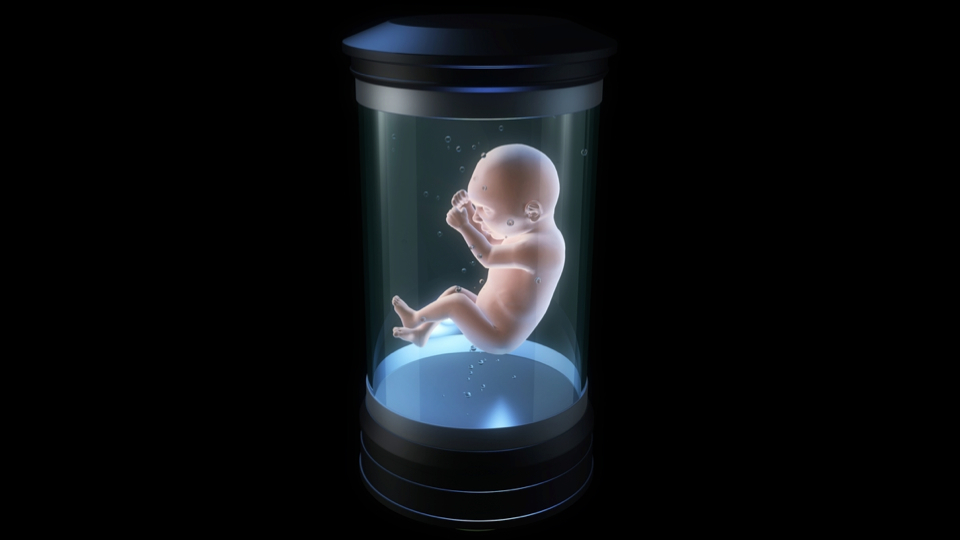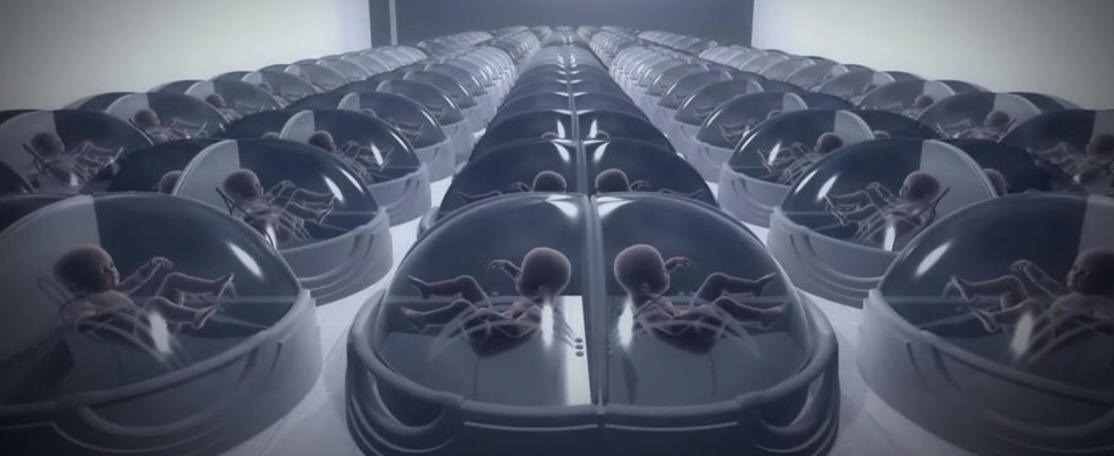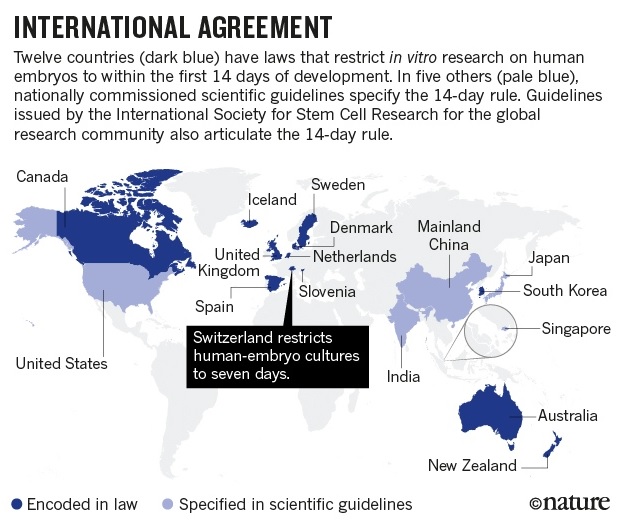ECTOGENESIS
CHILDBIRTH OUTSIDE THE WOMB
A REVOLUTION IN THE CREATION OF HUMAN LIFE

We live in an age of technological revolution. There are few revolutions that are more important than the biotechnological revolution. This ultimately involves the control and the manipulation of the human genetic code. We are not going to judge whether the biotechnology revolution in the human genetic code is moral or immoral. We'll let somebody else figure that out, but we are going to talk about is the inevitable reality of its appearance on the stage of human history. A key part of this revolution is the concept of ectogenesis, the creation of life outside the human womb, or the creation of artificial wombs. There is no way you can exaggerate the importance of this development.
Ectogenesis is a term that was coined by British biologist J.B.S. Haldane. Haldane imagined that ectogenesis would be developed and put to eugenic use in the 20th and 21st century. He predicted that by 2074, 70 percent of human births would take place through ectogenesis.
Now this process will completely revolutionize human life and motherhood as we know it. What this means is literally the mass production of life. You will no longer need a human mother for the creation of a human being. And this means you could mass-produce super soldiers. Farther along it will lead to the total and complete manipulation of the process of the creation of life altogether. In other words, why wait nine months? Maybe you could produce a new human in one month, or maybe two months. Another issue, why wait till someone's 21? This could produce humans that could grow to be adults in maybe four years. Or could be born at a much more advanced stage. The possibilities here are endless.
We don't really know the full scope of what is possible. But we do know that the groundwork for such technology is already being set and that ectogenesis will be an inevitable and very important part of the future to come. Today's political restrictions on research are going to be thrown away as history unfolds, and as the world's nations struggle against one another in the wake of future violence. Western leaders will put on a show of not wanting to do this, but they ultimately will, just as they have already violated many of the civil liberties that they have claimed to believe in. And it would not be a surprise if the Chinese were already working on this. After all, China has one of the fastest growing biotechnology sectors in the world, a sector that is now a billion dollar industry. So it is possible that in a lab somewhere in China, hidden from public scrutiny, ectogenesis is already a reality.
In the beginning there will be many deformed children and freak mistakes as a result of this process. Scientists will not get it perfect the first time. It's not going to be pretty. However, the global struggle for power will drive this process forward.

WHAT WE HAVE TODAY
IN VITRO FERTILIZATION
Now we already have the beginnings of ectogenesis with 'in vitro' fertilization. This is a process in which an egg is fertilized by sperm outside of the mother's body in vitro ("in glass"). This process involves careful monitoring and stimulation of the woman's ovulation process, removing an ovum (an egg) from the woman's ovaries and letting sperm fertilize the eggs in liquid in a laboratory. The fertilized egg (zygote) is cultured for 2-6 days in a growth medium and then is implanted in the uterus with the intention of leading to a successful pregnancy. The first successful instance of a "test tube baby" occurred in 1978 with Louise Brown. Because of this technology, women who are past their reproductive years or menopause can still become pregnant.
NEONATAL INTENSIVE CARE
In the 1990s, Japanese researchers succeeded in maintaining goat fetuses for weeks in a machine containing artificial amniotic fluid. At the same time, recent decades have seen the rapid growth of neonatal intensive care that is pushing back the minimum gestation age from which human fetuses can be kept alive. Today it is possible for a preterm fetus to survive when removed from the mother at a gestational age of slightly less than 22 weeks. That's only a little more than halfway through the pregnancy. And even though rescuing an infant delivered at such an early point requires sophisticated care and expensive equipment, as technology improves, this process will become more affordable and more widely available.
ARTIFICIAL WOMBS FOR MAMMALS IN EARLY PREGNANCY
A review published by the New York Academy of Sciences in 2011 highlights a series of achievements by various research groups using ex vivo (out of the body) uterus environments to support mammalian fetuses early in pregnancy.
WOMB TRANSPLANTS
This year, 10 British women who would normally be incapable of having children will have the opportunity to give birth. These women will receive womb transplants from donors that are classified as brain-dead, but have been kept alive. (The Guardian, 9-30-15). Womb transplants have already been a success in Sweden. (The Guardian, 1-13-14). These wombs do not directly connect the uteruses to the fallopian tubes, so these women are still unable to get pregnant naturally. Yet such a medical advance still moves science closer to creating artificial wombs that exist outside of the body completely.
HOW CLOSE ARE WE TO DEVELOPING CHILDREN OUTSIDE OF THE WOMB?
Some people believe this could take 20-30 more years to happen. This is the opinion of American-Hungarian futurist Zoltan Istvan on Motherboard. Other people think this could happen sooner.
RESEARCHING ARTIFICIAL WOMBS FOR HUMAN BEINGS
Ten years ago, Dr. Helen Hung-Ching Liu of Cornell University's Centre for Reproductive Medicine and Infertility said that she thinks this process could happen in a few years. 'We hope to create complete artificial wombs using these techniques in a few years,' said Dr. Liu. 'Women with damaged uteruses and wombs will be able to have babies for the first time.' (The Guardian, 2-10-02). In 2005, Dr. Liu said that she expects to have a fully functioning mouse womb in five to ten years and a human model soon after that. (Chicago-Kent Law Review, 2009)
To some degree Dr. Liu's prediction is already here, since scientists have successfully created artificial wombs in which embryos can grow outside of a woman's body. Scientists have created prototypes made out of cells extracted from women's bodies. Embryos have successfully attached themselves to the walls of these laboratory wombs and have started to grow. Yet many of these experiments had to be terminated after a few days to comply with in-vitro fertilization regulations. For instance, Liu was not permitted to complete her research in 2001, because the government did not allow research on human embryos beyond 14 days after conception, so Liu was forced to continue her work on mice instead. In 2003 she did successfully produce a mouse that gestated in a full-term extrernal uterus, but this mouse was deformed. She decided that her results would be better if there was some gestation inside a living animal rather than none. So she tried growing mouse embryos in the abdomen of mice, and indeed the results were better. The babies were smaller than normal, but not deformed. While her research sounds promising, she eventually stopped because of all the pressure from medical ethicists, activists and the media. (Business Insider, 2015).
"It turned out to have all of these social implications, and I didn't want to deal with it," Liu told Don.
The other notable success was a the research of Yoshinori Kuwabara, a gynaecologist at Tokyo University’s medical department, who removed the fetus from its mother by Caesarean section after 120 days’ gestation,
about three-quarters of the way to its full term. He placed it in a rubber womb filled with artificial amniotic fluid, and the kid was delivered 17 days later.
However, scientists still have yet to develop a fetus fully to term in an artificial womb without health defects. The closest success was Dr. Liu's mouse, but as noted above, this mouse was deformed.
THE CHALLENGES SCIENTISTS CURRENTLY FACE
While scientists have been successful in creating artificial wombs, there are still challenges with developing a fetus in that womb to full term. In addition to having a shell for the womb, there must be artificial amniotic fluids to surround the developing embryo, there needs to be a regulating device through which a fetus can receive the proper amount of oxygen, nutrients and hormones, and there are challenges in getting the blood vessels to form properly in the artificial wombs. Also, there is the challenge in extracting the fetus from the womb and implanting it into the artificial womb without damaging it.
According to io9, two primary areas that need to be developed further include biotechnology (for things like personalized genomics and tissue engineering) and nanotechnology (to facilitate micro-scale interactions and growth through artificial means). Smart computer systems and monitoring devices should also be developed to track the progress of the fetus’s growth, while automatically adjusting for changing conditions.
So while the use of artificial wombs remains a challenge, embryos can be successfully transferred from one animal to another. An embryo from a Bactrian camel was successfully transferred to a Dromedary. However, the ability of one species to survive inside inside the uterus of another is not always unidirectional. For example, a horse embryo can survive inside a donkey uterus, but a donkey embryo will perish in the uterus of an untreated mare (Next Human Project). But transferring an embryo to an artificial womb and raising it fully to term remains a challenge.
In May of 2016, scientists got a step closer to womb free births. Scientists managed to grow human embryos to at least 14 days old inside a petri dish. In fact, it’s possible that these embryos might even have kept growing past two weeks, if the scientists did not have to terminate them for ethical reasons. (Telegraph, 5-4-16).
While we're getting closer, there are still many things about the fetus that remain an unknown, and legal restrictions remain a major challenge to this research.
THE INTERNATIONAL LEGAL RESTRICTIONS ON EMBRYONIC GROWTH
The 14-day limit was first proposed in 1979 by the Ethics Advisory Board of the US Department of Health, Education, and Welfare. It was endorsed in 1984 by the Warnock committee in the United Kingdom, and in 1994 by the US National Institutes of Health's Human Embryo Research Panel.
In at least 12 countries, this limit is encoded in laws governing assisted reproduction and embryo research. The rule is also embodied in numerous reports commissioned by governments, and in scientific guidelines for embryo and assisted-reproduction research. These include China's 2003 Ethical Guiding Principles on Human Embryonic Stem Cell Research and India's 2007 Guidelines for Stem Cell Research and Therapy.

Some versions of the rule cover embryos by any means. Others apply only to products of fertilization. Some explicitly refer to gastrulation (when three different cell layers appear) or the formation of the primitive streak. Others mention only the 14 consecutive days of development. In most cases, however, what seems to be crucial is the stage of development that the 14th day typically represents, not the consecutive number of days in culture.
Yet it should be mentioned that when the rule was first proposed, until very recently, the internationally agreed upon rule hardly mattered because scientists were unable to keep human embryos alive outside of the body for more than a few days. Ironically, now that the limit might finally be practically relevant (meaning that it could function to stop scientists from doing something they might otherwise do), the suggestion is that the limit should be revisited. There are now many people who suggest that the limit should be increased to 21 days. (Impact Ethics).
THE INEVITABLITY OF THIS PROCESS
We believe that childbirth outside of the womb is inevitable. This will happen in the near future. Even if there are people in the west who see it as unethical, there are people in other parts of the world who will not. These people will not have the same religious qualms about human rights, the sanctity of the fetus, and so on and so forth. Since much of China's advanced genetic research is classified from the public, it is possible that research on this process could be going on right now. And perhaps in a lab somewhere hidden from public scrutiny, ectogenesis is already a reality.
In the beginning there will be many deformed children and freak mistakes as a result of this process. Scientists will not get it perfect the first time. There will be public outcry. But it will eventually happen.
People may raise moral questions about the practice, but if one country can successfully raise an entire generation of children without the use of traditional childbirth, there will be increased pressure on other governments to take part in this as well, including western governments that will initially resist the practice with claims that it is "immoral and unnatural." But it will be something that leaders will claim that we "must do," despite the moral implications, in order to remain competitive with the rest of the world.
RELATED WORLD FUTURE FUND ARTICLES
Biotechnology and Politics - Genetically Engineered Super Soldiers
The Inevitable Arms Race of the Near Future
STUDIES
The Artificial Womb (Annals of the New York Academy of Sciences, 3-14-11)
This study highlights a series of achievements by various research groups using ex vivo (out of the body) uterus environments to support mammalian fetuses early in pregnancy.
BOOKS
JBS Haldane, Daedalus, or, Science and the Future, 1923 (PDF)
Daedalus; or, Science and the Future is a book by the British scientist J. B. S. Haldane, published in England in 1924.
Haldane uses the Greek myth of Daedalus as a symbol for the revolutionary nature of science with particular regard to his own discipline of biology.
The book is an early vision of transhumanism and his vision of a future in which humans controlled their own evolution through directed mutation and use of ectogenesis.
RELATED NEWS ARTICLES
'Artificial womb' breakthrough sparks row over how long human embryos should be kept in lab (Telegraph, 5-4-16)
Artificial uterus: How close is the reality? (Genetic Literacy Project, 4-6-16)
IVF: What Are Test Tube Babies? (Medical News Today, 1-26-16)
Artificial wombs: The coming era of motherless births? (Genetic Literacy Project, 6-12-15)
Artificial Wombs Are Coming, but the Controversy Is Already Here (Motherboard, 8-4-14)
How to Build an Artificial Womb (io9, 4-19-13)
What Do Artificial Wombs Mean for Women? (Rewire, 2-23-12)
Artificial Wombs: Delivering on Fertile Promises (Harvard, 2008)